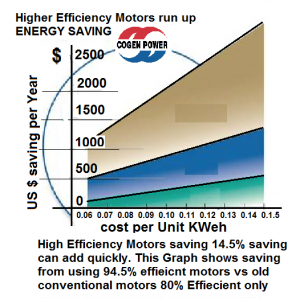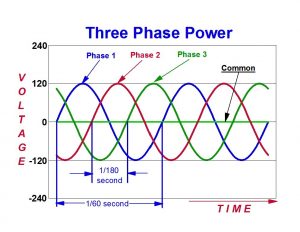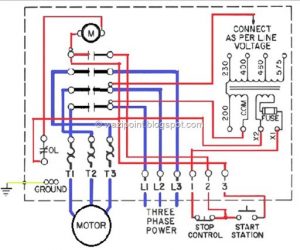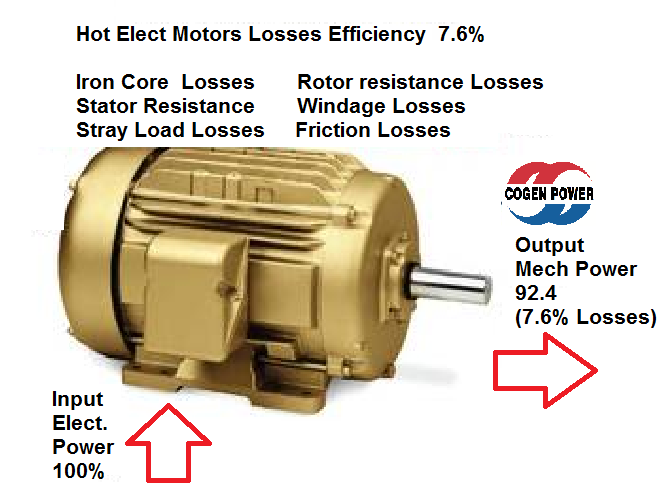By Engr. Khalid Saeed
Principal Design Engineer (CEO) Cogen Consult
36 Years in Power Plants Industries, Member of PEC (Pak 1981),MIE, ASME, ASRAE, IEEE, HVACR, EPA, NFPA,
In Pakistan most of the 3 Phase Electric motors running are most deficiently & 75%+/-5) instead of 95% required today.
It is normal practice by old Forman / Technician to get re-winded again and again from local cottage Electrician.
Proper Graduate Engineers are not involves in day to day failure and maintenance cost?
Locally re-winded motors are cheated by Copper cable winding gauge, No of turns, quality of Isolation/insulation warmish, poor soaking drying methods, no tests, no comparison for Current & Torque tests. Causing 15% + More Electricity Bills.
A three-phase electric motor is often able to run for many years before any serious problems occur. Testing the motor on a regular basis as part of a preventative maintenance program helps extend the life & Efficiency of the motor.
A three-phase electric motor is often able to run for many years before any serious problems occur. Testing the motor on a regular basis as part of a preventative maintenance program helps extend the life & Efficiency of the motor.


Testing the 3-phase motor
Check the motor with a volt-ohmmeter set to ohms. Attach the leads from the motor to each of the power connections. The motor reads either over-limit (OL) or infinite ohms. If not, the motor is bad, and it may be necessary to replace it.
Polarization index test (PI): Sometimes called a 10 min to 1 min insulation resistance test, the PI checks the insulation resistance. It also monitors the health of the motor and determines if there is excessive moisture present.
Megger testing: This test determines if there is a problem with the insulation. It is a good option for testing a three-phase motor because it does not cause more damage during the testing process. It uses a high-voltage insulation tester to check the insulation within the circuit.
Surge test: The surge test is an old test, but it is still an efficient way to determine if the winding insulation is experiencing problems. It also determines if there are defects in coil-to-coil, face-to-face, or turn to turn sometimes missed by other types of testing processes.
Performing in-house tests often saves considerable time and frustration. These tests also save a significant amount of money. It is also important to use qualified technicians that understand these testing processes to get the best results.
For high-efficiency motors, it is important to note that this term really refers to traditionally architected electric motors consisting of armature and field windings.
“Induction motors are available in standard-, high- and premium-efficiency models, whereas permanent magnet motors are not.
The reason is that the permanent-magnet electric motor architecture is inherently more efficient, since no power is used to establish the stator magnetic field.
AC induction motors have a family of motors that comply with NEMA Premium Efficiency per NEMA MG 1, tables 12-12 and 12-13, and IEC 60034- 30 for IE3 efficiency.” Induction 3 Phase motors having Stator coils wound on ferromagnetic cores,
“Premium motors, are built to closer tolerances than older motors, run cooler, have less vibration, are quieter, and last longer.”
High Efficiency in Motors is achieved by improving the energy conversion paths and physical properties with new slot and winding geometries, advanced magnet and core materials, and the use of copper rotors for ac induction motors.”

What makes a motor efficient?
“The key to higher efficiency is reducing losses by
- More copper in the winding to reduce stator losses
- Higher-grade electrical steel reduces iron-core losses. Lower losses mean fewer watts to cool so smaller fans can be used, reducing losses Shaft Power)
- Stator conductive losses in the stator and rotor and
- core losses, also called iron or hysteric losses.
Efficient Elect Motors Properties
- Winding Resistance—As winding resistance increases, efficiency decreases. To maximize motor efficiency, motor designers minimize resistance by maximizing slot fill (amount of copper windings in the stator slots) and minimizing end-turn radius (amount of copper windings outside the stator slots).
- Lamination Material Core losses are directly influenced by the material properties and quality of the steel used in the stator laminations.
- Thinner laminations will lead to lower core losses in the stator than thicker laminations.
- Lamination Tooth Geometry

It’s the system that counts every KWe
“The goal in most factory automation and industrial applications is efficient use of energy with the highest productivity. Therefore it is essential to analyze, model, and optimize the complete system before investing in individual components, like new motors.”
Better motors are easy to do as drop-in replacements for less efficient units, but efficiency gains are limited.
Using a 95% efficient motor is good but not when connected to a double-reduction [gear train] that is 50% to 60% efficient, when a helical or bevel speed reducer may be 90% to 95% efficient.”
What not to do Prevetion & caution;
“The biggest mistakes, warned, “are made by engineers just focusing on the name plate efficiency of the motor, and expecting similar percentage energy savings in their specific application.
Different motors have different characteristics, which have to be matched to the application to benefit from the investment in a higher efficiency motor. For example, a more expensive premium efficiency ac induction motor will not save much energy if it’s run at partial load or idling for long periods of time.
Replacing a much older motor with a new premium motor on a centrifugal pump
The impeller would have been sized for the old motor’s speed. However, the new, more efficient, motor likely will run faster under the same load, leading to more overall power use. The system might be more energy-efficient, but the additional work it does may not provide any benefit.
Old motors replacement need review of the overall machine design. Even a perfectly efficient motor, if connected to a poorly designed mechanical system, will not produce significant benefits with respect to energy savings.







